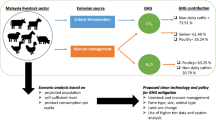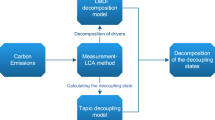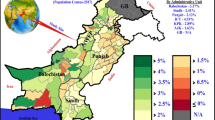Abstract
The livestock sector not only provides people with meat, eggs, milk, and other nutrients but also causes a large number of non-CO2 greenhouse gas emissions. It is urgent to explore the influence mechanism of non-CO2 greenhouse gas emission from the livestock sector and formulate effective mitigation strategies. Taking Jiangsu province as an example, we analyzed the influencing factors of non-CO2 greenhouse gas emissions from the livestock sector based on sources and modified the STIRPAT (stochastic impact by regression on population, affluence, and technology) model, proposed the directions, designed the generally circular path, and determined the focus of non-CO2 greenhouse gas emissions reduction from the livestock sector. The results demonstrated: (1) the top priority of emission reduction of livestock sector in Jiangsu province was the reasonable treatment of manure produced by livestock (non-CO2 greenhouse gas emissions from manure had accounted for more than 60% of the total emissions from the livestock sector since 2007.), and the core was pig manure management (the CH4 and N2O emissions from pig manure accounted for more than 90 and 50% of the total CH4 and N2O emissions from all livestock manure, respectively). (2) The decrease of the agricultural population, the increase of livestock output value per capita of the agricultural population, and the improvement of livestock carbon productivity all reduced non-CO2 greenhouse gas emissions of the livestock sector. For every 1% decrease in agricultural population, for every 1% increase in livestock carbon productivity and livestock output value per capita of the agricultural population, non-CO2 greenhouse gas emissions from the livestock sector would be reduced by 0.0859%, 0.1748%, and 0.0400%, respectively. (3) To construct and improve the low carbon industrial chain of the livestock sector, to promote low carbon technology research and development and introduction are two focuses for non-CO2 greenhouse gas emission reduction in the livestock sector. The research can provide a basis for non-CO2 greenhouse gas emissions reduction from the livestock sector in China, especially in the developed eastern regions.




Similar content being viewed by others
Data availability
Not applicable.
References
Behrens P, Kiefte-de Jong JC, Bosker T, Rodrigues JF, De Koning A, Tukker A (2017) Evaluating the environmental impacts of dietary recommendations. Proc Natl Acad Sci 114(51):13412–13417
Cai T, Yang D, Zhang X, Xia F, Wu R (2018) Study on the vertical linkage of greenhouse gas emission intensity change of the animal husbandry sector between China and its provinces. Sustainability 10(7):2492
Cai T, Xia F, Yang D, Huo J, Zhang Y (2019) Decomposition of factors affecting changes in non-CO2 greenhouse gas emission intensity of China’s livestock sector based on the concept of “environment–food–economy.” Sci Total Environ 691:611–620
Carlson KM, Gerber JS, Mueller ND, Herrero M, Macdonald GK, Brauman KA et al (2017) Greenhouse gas emissions intensity of global croplands. Nat Clim Chang 7:63–68
Chaudhary A, Krishna V (2019) Country-specific sustainable diets using optimization algorithm. Environ Sci Technol 53(13):7694–7703
Clark MA, Domingo NGG, Colgan K, Thakrar SK, Tilman D, Lynch J et al (2020) Global food system emissions could preclude achieving the 1.5 and 2℃climate change targets. Science 370:705–708
FAO (2016) The state of food and agriculture climate change, agriculture and food security. Rome, Italy, 15–16
Frank S, Havlík P, Stehfest E, van Meijl H, Witzke P, Pérez-Domínguez I, van Dijk M, Doelman JC, Fellmann T, Koopman JFL, Tabeau A, Valin H (2018) Agricultural non-CO2 emission reduction potential in the context of the 1.5 °C target. Nat Clim Chang 9(1):66–72
Gerber P, Gill M, Butterbach-Bahl K, Valin H, Garnett T, Stehfest E (2016) Greenhouse gas mitigation potentials in the livestock sector. Nat Clim Chang 6:452–461
Havlik P, Valin H, Herrero M, Obersteiner M, Schmid E, Rufino MC, Mosnier A, Thornton PK, Bottcher H, Conant RT, Frank S, Fritz S, Fuss S, Kraxner F, Notenbaert A (2014) Climate change mitigation through livestock system transitions. Proc Natl Acad Sci 111:3709–3714
Herrero M, Henderson B, Havlík P, Thornton PK, Conant RT, Smith P, Wirsenius S, Hristov AN, Gerber P, Gill M, Butterbach-Bahl K, Valin H, Garnett T, Stehfest E (2016) Greenhouse gas mitigation potentials in the livestock sector. Nat Clim Chang 6:452–461
Hong C, Burney JA, Pongratz J et al (2021) Global and regional drivers of land-use emissions in 1961–2017. Nature 589:554–561
IPCC (2014) In: Core Writing Team, Pachauri RK, Meyer LA (eds) Climate change 2014: synthesis report. Contribution of Working Groups I, II and III to the Fifth Assessment Report of the Intergovernmental Panel on Climate Change. IPCC, Geneva, Switzerland
IPCC (2006) IPCC guidelines for national greenhouse gas inventories volume 4:agriculture, forestry and other land use. IPCC, Geneva
IPCC (2007) In: Core Writing Team, Pachauri RK, Reisinger A (eds) Climate change 2007: synthesis report. Contribution of Working Groups I, II and III to the Fourth Assessment Report of the Intergovernmental Panel on Climate Change. IPCC, Geneva, Switzerland
Liao C, Nolte K, Sullivan JA et al (2021) Carbon emissions from the global land rush and potential mitigation. Nat Food 2:15–18
Lin J, Hu Y, Cui S, Kang J, Xu L (2015) Carbon footprints of food production in China (1979–2009). J Clean Prod 90:97–103
Luo T, Yue Q, Yan M, Cheng K, Pan G (2015) Carbon footprint of China’s livestock system – a case study of farm survey in Sichuan province, China. J Clean Prod 102:136–143
Luo Y, Long X, Wu C, Zhang J (2017) Decoupling CO2 emissions from economic growth in agricultural sector across 30 Chinese provinces from 1997 to 2014. J Clean Prod 159:220–228
Meng X, Cheng G, Zhang J, Wang Y, Zhou H (2014) Analyze on the spatialtemporal characteristics of GHG estimation of livestock’s by life cycle assessment in China. China Environ Sci 34:2167–2176
NCCC (National Coordination Committee on Climate Change) (2012) Second national communication on climate change of the People’s Republic of China. NCCC, Beijing
NDRCC (National Development and Reform Commission of China) (2013) Guidelines for the Development of Low Carbon and Provincial Greenhouse Gas Inventories (Beijing, China)
Reisinger A, Clark H (2017) How much do direct livestock emissions actually contribute to global warming? Glob Chang Boil 24:1749–1761
Song G, Gao X, Fullana-i-Palmer P, Lv D, Zhu Z, Wang Y, Bayer LB (2019) Shift from feeding to sustainably nourishing urban China: a crossing-disciplinary methodology for global environment-food-health nexus. Sci Total Environ 647:716–724
Springmann M, Clark M, Mason-D’Croz D, Wiebe K, Bodirsky BL, Lassaletta L, de Vries W, Vermeulen SJ, Herrero M, Carlson KM, Jonell M, Troell M, DeClerck F, Gordon LJ, Zurayk R, Scarborough P, Rayner M, Loken B, Fanzo J, Godfray HCJ, Tilman D, Rockström J, Willett W (2018) Options for keeping the food system within environmental limits. Nature 562:519–525
Tian Y, Zhang JB, He YY (2014) Research on spatial-temporal characteristics and driving factor of agricultural carbon emissions in China. J Integr Agric 13(6):1393–1403
Tilman D, Clark M (2014) Global diets link environmental sustainability and human health. Nature 515:518–522
Wang W, Koslowski F, Nayak DR, Smith P, Saetnan E, Ju X, Guo L, Han G, de Perthuis C, Lin E, Moran D (2014) Greenhouse gas mitigation in Chinese agriculture: distinguishing technical and economic potentials. Glob Environ Chang 26:53–62
Xiong C, Yang D, Xia F, Huo J (2016) Changes in agricultural carbon emissions and factors that influence agricultural carbon emissions based on different stages in Xinjiang. China Sci Rep 6:36912
Xiong C, Chen S, Yang D (2019) Selecting counties to participate in agricultural carbon compensation in China. Pol J Environ Stud 28(3):1443–1449
Xiong C, Chen S, Xu L (2020a) Driving factors analysis of agricultural carbon emissions based on extended STIRPAT model of Jiangsu province, China. Growth Chang 51:1401–1416
Xiong C, Wang G, Xu L (2021a) Spatial differentiation identification of influencing factors of agricultural carbon productivity at city level in Taihu lake basin, China. Sci Total Environ 800:149610
Xiong C, Wang G, Su W, Gao Q (2021) Selecting low carbon technologies and measures for high agricultural carbon productivity in Taihu Lake Basin, China. Environ Sci Pollut Res 28:49913–49920
Xiong C, Guo Z, Chen SS, Gao Q, Kish MA, Shen Q (2020b) Understanding the pathway of phosphorus metabolism in urban household consumption system: a case study of Dar es Salaam, Tanzania. J Clean Prod 274:122874
Xu X, Lan Y (2016) A comparative study on carbon footprints between plant-and animal-based foods in China. J Clean Prod 112:2581–2592
Xue B, Wang LZ, Yan T (2014) Methane emission inventories for enteric fermentation and manure management of yak, buffalo and dairy and beef cattle in China from 1988 to 2009. Agric Ecosyst Environ 195:202–210
Yao C, Qian S, Li Z et al (2017) Provincial animal husbandry carbon emissions in China and temporal-spatial evolution mechanism. Resour Sci 39:698–712. (In Chinese)
Yin J, Zhang X, Huang W, Liu L, Zhang Y, Yang D, Hao Y, Chen Y (2021) The potential benefits of dietary shift in China: synergies among acceptability, health, and environmental sustainability. Sci Total Environ 779:146497
Yue Q, Xu X, Hillier J, Cheng K, Pan G (2017) Mitigating greenhouse gas emissions in agriculture: from farm production to food consumption. J Clean Prod 149:1011–1019
Zhuang M, Gongbuzeren, Li W (2017) Greenhouse gas emission of pastoralism is lower than combined extensive/intensive livestock husbandry: a case study on the Qinghai-Tibet Plateau of China. J Clean Prod 147:514–522
Acknowledgements
I am very grateful to the editors and anonymous reviews for reviewing this paper.
Funding
This work was supported by the National Key R&D Program of China (no. 2018YFD1100101), the National Natural Sciences Foundation of China (42001133), and the Jiangsu Natural Science Foundation (BK20181105).
Author information
Authors and Affiliations
Contributions
Chuanhe Xiong: data curation, methodology, writing—original draft, and validation. Weizhong Su: writing—reviewing and editing. Hengpeng Li: writing—reviewing and editing. Zheng Guo: investigation.
Corresponding authors
Ethics declarations
Ethics approval
Not applicable.
Consent to participate
Not applicable.
Consent to publish
Not applicable.
Competing interests
The authors declare no competing interests.
Additional information
Responsible Editor: Philippe Garrigues
Publisher's note
Springer Nature remains neutral with regard to jurisdictional claims in published maps and institutional affiliations.
Supplementary Information
Below is the link to the electronic supplementary material.
Rights and permissions
About this article
Cite this article
Xiong, C., Su, W., Li, H. et al. Influencing mechanism of non-CO2 greenhouse gas emissions and mitigation strategies of livestock sector in developed regions of eastern China: a case study of Jiangsu province. Environ Sci Pollut Res 29, 39937–39947 (2022). https://doi.org/10.1007/s11356-022-18937-1
Received:
Accepted:
Published:
Issue Date:
DOI: https://doi.org/10.1007/s11356-022-18937-1




